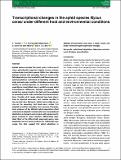Transcriptional changes in the aphid species Myzus cerasi under different host and environmental conditions
Abstract
Aphids feature complex life cycles, which in the case of many agriculturally important species involve primary and secondary host plant species. Whilst host alternation between primary and secondary host can occur in the field depending on host availability and the environment, aphid populations maintained as laboratory stocks generally are kept under conditions that allow asexual reproduction by parthenogenesis on secondary hosts. We used Myzus cerasi (black cherry aphid) to assess aphid transcriptional differences between populations collected from primary hosts in the field and those adapted to secondary hosts under controlled environment conditions. Transfer of M. cerasi collected from local cherry trees to reported secondary host species resulted in low survival rates. Moreover, aphids were unable to survive on the secondary host land cress, unless first adapted to another secondary host, cleavers. Transcriptome analyses of the different aphid populations (field collected and adapted) revealed extensive transcriptional plasticity to a change in environment, with predominantly genes involved in redox reactions differentially regulated. Most of the differentially expressed genes were duplicated and we found evidence for differential exon usage. Our data suggest that aphid adaptation to different environments may pose a major hurdle and leads to extensive gene expression changes.
Citation
Thorpe , P , Escudero-Martinez , C M , Eves-van den Akker , S & Bos , J I B 2020 , ' Transcriptional changes in the aphid species Myzus cerasi under different host and environmental conditions ' , Insect Molecular Biology , vol. Early View . https://doi.org/10.1111/imb.12631
Publication
Insect Molecular Biology
Status
Peer reviewed
ISSN
0962-1075Type
Journal article
Description
This work was supported by the Biotechnology and Biological Sciences Research Council (BB/R011311/ to S.E.‐vd A.), European Research Council (310190‐APHIDHOST to J.I.B.B.), and the Royal Society of Edinburgh (fellowship to J.I.B.B.). Bioinformatics and computational analyses were supported by the University of St Andrews Bioinformatics Unit, which is funded by a Wellcome Trust Institutional Strategic Support Fund award (grant 105621/Z/14/Z).Collections
Items in the St Andrews Research Repository are protected by copyright, with all rights reserved, unless otherwise indicated.

